Optical and Electrical Properties of AlxGa1−xN/GaN Epilayers Modulated by Aluminum Content
Abstract
1. Introduction
2. Results and Discussion
2.1. High Resolution X-ray Diffraction Study
2.2. X-ray Photoelectron Spectroscopy Study
2.3. Photoluminescence Study
2.4. Hall Effect Measurements
3. Materials and Methods
4. Conclusions
Author Contributions
Funding
Institutional Review Board Statement
Informed Consent Statement
Data Availability Statement
Conflicts of Interest
References
- Pandit, B.; Schubert, E.F.; Cho, J. Dual-functional ultraviolet photodetector with graphene electrodes on AlGaN/GaN heterostructure. Sci. Rep. 2020, 10, 22059. [Google Scholar] [CrossRef] [PubMed]
- Lucie, V.; Vincent, G.; Sylvain, F.; Catherine, B.; Joël, E.; Gwénolé, J.; Christophe, D. M-plane AlGaN digital alloy for microwire UV-B LEDs. Appl. Phys. Lett. 2023, 122, 141101. [Google Scholar] [CrossRef]
- Khaouani, M.; Hamdoune, A.; Bencherif, H.; Kourdi, Z.; Dehimi, L. An ultra-sensitive AlGaN/AlN/GaN/AlGaN photodetector: Proposal and investigation. Optik 2020, 217, 164797. [Google Scholar] [CrossRef]
- Daqing, P.; Zhonghui, L.; Chuanhao, L.; Qiankun, Y.; Dongguo, Z.; Weike, L.; Xun, D. Low stress AlGaN/GaN heterojuction with AlGaN buffer grown on 6-inch semi-insulating SiC substrate. J. Cryst. Growth 2023, 611, 127184. [Google Scholar] [CrossRef]
- Xue, D.; Zhang, H.; Liu, J.; Xia, X.; Guo, W.; Huang, H.; Xu, N.; Xi, Q.; Liang, H. Improved performance of AlGaN/GaN HEMT based H+ sensors by surface hydroxylation treatment. Mater. Sci. Semicond. Process 2021, 121, 105386. [Google Scholar] [CrossRef]
- Xiaobiao, H.; Wang, L.; Qiliang, W.; Shaoheng, C.; Liuan, L.; Liang, H. Design of normally-off p-GaN/AlGaN/GaN heterojunction field-effect transistors with re-grown AlGaN barrier. J. Cryst. Growth 2023, 607, 127106. [Google Scholar] [CrossRef]
- Li, L.; Yamaguchi, R.; Wakejima, A. Polarization engineering via InAlN/AlGaN heterostructures for demonstration of normally-off AlGaN channel field effect transistors. Appl. Phys. Lett. 2020, 117, 152108. [Google Scholar] [CrossRef]
- Hou, Y.; Wang, B.; Yang, J.; Zhang, y.; Zhang, Z.; Liang, F.; Liu, Z.; Zhao, D. Influence of growth interruption on the morphology and luminescence properties of AlGaN/GaN ultraviolet multi-quantum wells. Opt. Express 2023, 31, 39695–39702. [Google Scholar] [CrossRef]
- Tang, L.; Tang, B.; Zhang, H.; Yuan, Y. Review—Review of Research on AlGaN MOCVD Growth. ECS J. Solid State Sci. Technol. 2020, 9, 024009. [Google Scholar] [CrossRef]
- Gu, L.; Yang, S.; Miao, B.; Gu, Z.; Wang, J.; Sun, W.; Wu, D.; Li, J. Electrical detection of trace zinc ions with an extended gate-AlGaN/GaN high electron mobility sensor. Analyst 2019, 144, 663–668. [Google Scholar] [CrossRef]
- Ma, Z.; Cao, H.; Lin, S.; Li, X.; Zhao, L. Degradation and failure mechanism of AlGaN-based UVC-LEDs. Solid-State Electron. 2019, 156, 92–96. [Google Scholar] [CrossRef]
- Narang, K.; Bag, R.K.; Singh, V.K.; Pandey, A.; Saini, S.K.; Khan, R.; Arora, A.; Padmavati, M.V.G.; Tyagi, R.; Singh, R. Improvement in surface morphology and 2DEG properties of AlGaN/GaN HEMT. J. Alloys Compd. 2020, 815, 152283. [Google Scholar] [CrossRef]
- Khan, M.A.K.; Alim, M.A.; Gaquiere, C. 2DEG transport properties over temperature for AlGaN/GaN HEMT and AlGaN/InGaN/GaN pHEMT. Microelectron. Eng. 2021, 238, 111508. [Google Scholar] [CrossRef]
- Sun, Y.; Wang, Y.; Tang, J.; Wang, W.; Huang, Y.; Kuang, X. A Breakdown Enhanced AlGaN/GaN Schottky Barrier Diode with the T-Anode Position Deep into the Bottom Buffer Layer. Micromachines 2019, 10, 91. [Google Scholar] [CrossRef] [PubMed]
- Kaun, S.W.; Wong, M.H.; Mishra, U.K.; Speck, J.S. Correlation between threading dislocation density and sheet resistance of AlGaN/AlN/GaN heterostructures grown by plasma-assisted molecular beam epitaxy. Appl. Phys. Lett. 2012, 100, 262102. [Google Scholar] [CrossRef]
- Jiyu, Z.; Xiaobo, L.; Taofei, P.; Yue, H.; Xiao, W.; Yuyu, B.; Liuan, L.; Jin-Ping, A. Surface sensibility and stability of AlGaN/GaN ion-sensitive field-effect transistors with high Al-content AlGaN barrier layer. Appl. Surf. Sci. 2021, 570, 151190. [Google Scholar] [CrossRef]
- Kakanakova-Georgieva, A.; Ivanov, I.G.; Suwannaharn, N.; Hsu, C.-W.; Cora, I.; Pécz, B.; Giannazzo, F.; Sangiovanni, D.G.; Gueorguiev, G.K. MOCVD of AlN on epitaxial graphene at extreme temperatures. CrystEngComm 2021, 23, 385–390. [Google Scholar] [CrossRef]
- Alves Machado Filho, M.; Hsiao, C.L.; Dos Santos, R.B.; Hultman, L.; Birch, J.; Gueorguiev, G.K. Self-Induced Core-Shell InAlN Nanorods: Formation and Stability Unraveled by Ab Initio Simulations. ACS Nanosci Au 2023, 3, 84–93. [Google Scholar] [CrossRef]
- Zhang, Q.; Li, Q.; Zhang, W.; Zhang, H.; Zheng, F.; Zhang, M.; Hu, P.; Wang, M.; Tian, Z.; Li, Y.; et al. Phase transition and bandgap engineering in B1-xAlxN alloys: DFT calculations and experiments. Appl. Surf. Sci. 2022, 575, 151641. [Google Scholar] [CrossRef]
- Ajayan, J.; Nirmal, D.; Mohankumar, P.; Mounika, B.; Bhattacharya, S.; Tayal, S.; Fletcher, A.S.A. Challenges in material processing and reliability issues in AlGaN/GaN HEMTs on silicon wafers for future RF power electronics & switching applications: A critical review. Mater. Sci. Semicond. Process. 2022, 151, 106982. [Google Scholar] [CrossRef]
- Xu, R.; Kang, Q.; Zhang, Y.; Zhang, X.; Zhang, Z. Research Progress of AlGaN-Based Deep Ultraviolet Light-Emitting Diodes. Micromachines 2023, 14, 844. [Google Scholar] [CrossRef] [PubMed]
- Mishra, M.; Gupta, G. Electronic properties and oxygen chemisorption at AlxGa1−xN surfaces. Mater. Chem. Phys. 2020, 239, 122106. [Google Scholar] [CrossRef]
- Kim, H.; Yun, H.J.; Choi, S.; Choi, B.J. Comparison of electrical and interfacial characteristics between atomic-layer-deposited AlN and AlGaN on a GaN substrate. Appl. Phys. A 2020, 126, 449. [Google Scholar] [CrossRef]
- Arivazhagan, P.; Ramesh, R.; Kumar, R.R.; Faulques, E.; Bennis, F.; Baskar, K. Structural and electrical characteristics of GaN, n-GaN and AlxGa1−xN. J. Alloys Compd. 2016, 656, 110–118. [Google Scholar] [CrossRef]
- Meng, Q.; Lin, Q.; Jing, W.; Mao, Q.; Zhao, L.; Fang, X.; Dong, T.; Jiang, Z. Characterization of the Electrical Properties of a Double Heterostructure GaN/AlGaN Epitaxial Layer with an AlGaN Interlayer. J. Electron. Mater. 2021, 50, 2521–2529. [Google Scholar] [CrossRef]
- Kakanakova-Georgieva, A.; Nilsson, D.; Stattin, M.; Forsberg, U.; Haglund, Å.; Larsson, A.; Janzén, E. Mg-doped Al0.85Ga0.15N layers grown by hot-wall MOCVD with low resistivity at room temperature. Phys. Status Solidi (RRL) Rapid Res. Lett. 2010, 4, 311–313. [Google Scholar] [CrossRef]
- Van de Walle, C.G.; Stampfl, C.; Neugebauer, J.; McCluskey, M.D.; Johnson, N.M. Doping of AlGaN Alloys. MRS Internet J. Nitride Semicond. Res. 1999, 4, 890–901. [Google Scholar] [CrossRef]
- Zhang, H.; Sun, Y.; Hu, K.; Yang, L.; Liang, K.; Xing, Z.; Wang, H.; Zhang, M.; Yu, H.; Fang, S.; et al. Boosted high-temperature electrical characteristics of AlGaN/GaN HEMTs with rationally designed compositionally graded AlGaN back barriers. Sci. China Inf. Sci. 2023, 66, 182405. [Google Scholar] [CrossRef]
- Luong, T.-T.; Tran, B.T.; Ho, Y.-T.; Ha, M.-T.-H.; Hsiao, Y.-L.; Liu, S.-C.; Chiu, Y.-S.; Chang, E.-Y. Performance improvements of AlGaN/GaN HEMTs by strain modification and unintentional carbon incorporation. Electron. Mater. Lett. 2015, 11, 217–224. [Google Scholar] [CrossRef]
- Tao, H.; Xu, S.; Su, H.; Zhang, T.; Zhang, J.; Zhang, Y.; Gao, Y.; Liu, X.; Lu, H.; Xie, L.; et al. Improved crystal quality of AlGaN by Al ion-implantation sapphire substrate. Mater. Lett. 2023, 351, 135097. [Google Scholar] [CrossRef]
- Wang, S.; Zhang, X.; Yang, H.; Cui, Y. Effect of fluctuation in Al incorporation on the microstructure, bond lengths, and surface properties of an AlxGa1−xN epitaxial layer. Electron. Mater. Lett. 2015, 11, 675–681. [Google Scholar] [CrossRef]
- Xu, Y.-N.; Ching, W. Electronic, optical, and structural properties of some wurtzite crystals. Phys. Rev. B 1993, 48, 4335. [Google Scholar] [CrossRef] [PubMed]
- Monemar, B.; Bergman, J.; Buyanova, I. GaN and Related Materials: Optical Characterisation of GaN and Related Materials; CRC Press: Boca Raton, FL, USA, 2021; pp. 85–139. [Google Scholar]
- Yamashita, H.; Fukui, K.; Misawa, S.; Yoshida, S. Optical properties of AlN epitaxial thin films in the vacuum ultraviolet region. J. Appl. Phys. 1979, 50, 896–898. [Google Scholar] [CrossRef]
- Wei, W.; Peng, Y.; Yang, Y.; Xiao, K.; Maraj, M.; Yang, J.; Wang, Y.; Sun, W. Study of Defects and Nano-patterned Substrate Regulation Mechanism in AlN Epilayers. Nanomaterials 2022, 12, 3937. [Google Scholar] [CrossRef]
- Arivazhagan, P.; Ramesh, R.; Jayasakthi, M.; Loganathan, R.; Balaji, M.; Baskar, K. Structural and carrier dynamics of GaN and AlGaN-based double heterostructures in the UV region. J. Electron. Mater. 2013, 42, 2486–2491. [Google Scholar] [CrossRef]
- Nemoz, M.; Dagher, R.; Matta, S.; Michon, A.; Vennéguès, P.; Brault, J. Dislocation densities reduction in MBE-grown AlN thin films by high-temperature annealing. J. Cryst. Growth 2017, 461, 10–15. [Google Scholar] [CrossRef]
- Wallis, D.J.; Zhu, D.; Oehler, F.; Westwater, S.P.; Pujol, A.; Humphreys, C.J. Measuring the composition of AlGaN layers in GaN based structures grown on 150 mm Si substrates using (2 0 5) reciprocal space maps. Semicond. Sci. Technol. 2013, 28, 094006. [Google Scholar] [CrossRef]
- Feng, Y.; Saravade, V.; Chung, T.-F.; Dong, Y.; Zhou, H.; Kucukgok, B.; Ferguson, I.T.; Lu, N. Strain-stress study of AlxGa1−xN/AlN heterostructures on c-plane sapphire and related optical properties. Sci. Rep. 2019, 9, 10172. [Google Scholar] [CrossRef]
- Yin, J.; Chen, D.; Yang, H.; Liu, Y.; Talwar, D.N.; He, T.; Ferguson, I.T.; He, K.; Wan, L.; Feng, Z.C. Comparative spectroscopic studies of MOCVD grown AlN films on Al2O3 and 6H–SiC. J. Alloys Compd. 2021, 857, 157487. [Google Scholar] [CrossRef]
- Loganathan, R.; Jayasakthi, M.; Prabakaran, K.; Ramesh, R.; Arivazhagan, P.; Baskar, K. Studies on dislocation and surface morphology of AlxGa1−xN/GaN heterostructures grown by MOCVD. J. Alloys Compd. 2014, 616, 363–371. [Google Scholar] [CrossRef]
- Jena, D.; Gossard, A.C.; Mishra, U.K. Dislocation scattering in a two-dimensional electron gas. Appl. Phys. Lett. 2000, 76, 1707–1709. [Google Scholar] [CrossRef]
- Hájek, F.; Hospodková, A.; Hubík, P.; Gedeonová, Z.; Hubáček, T.; Pangrác, J.; Kuldová, K. Transport properties of AlGaN/GaN HEMT structures with back barrier: Impact of dislocation density and improved design. Semicond. Sci. Technol. 2021, 36, 075016. [Google Scholar] [CrossRef]
- Lu, L.; Shen, B.; Xu, F.; Gao, B.; Huang, S.; Miao, Z.; Qin, Z.; Yang, Z.; Zhang, G.; Zhang, X. Morphology and microstructure evolution of AlxGa1−xN epilayers grown on GaN/sapphire templates with AlN interlayers observed by transmission electron microscopy. J. Appl. Phys. 2008, 103, 113510. [Google Scholar] [CrossRef]
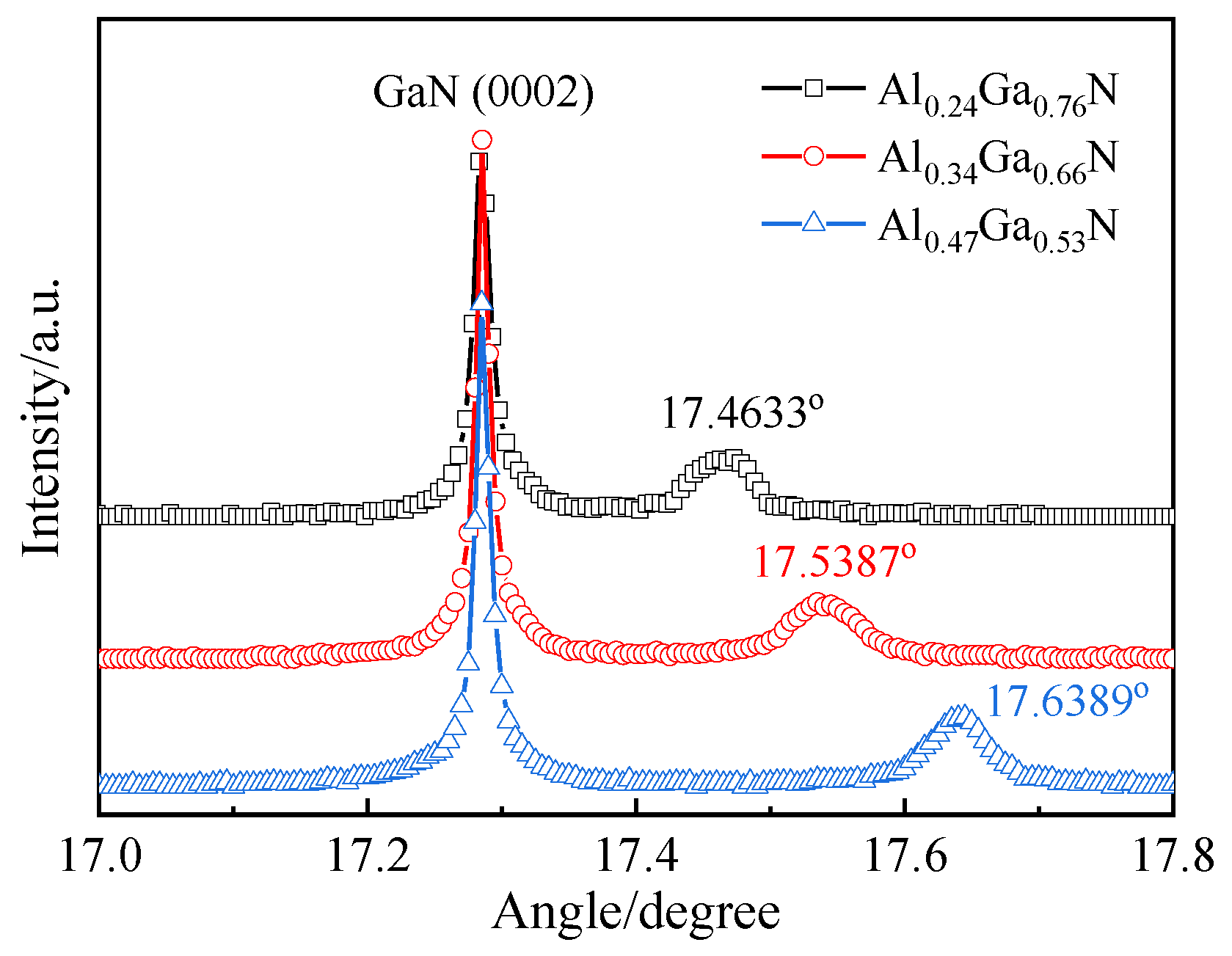
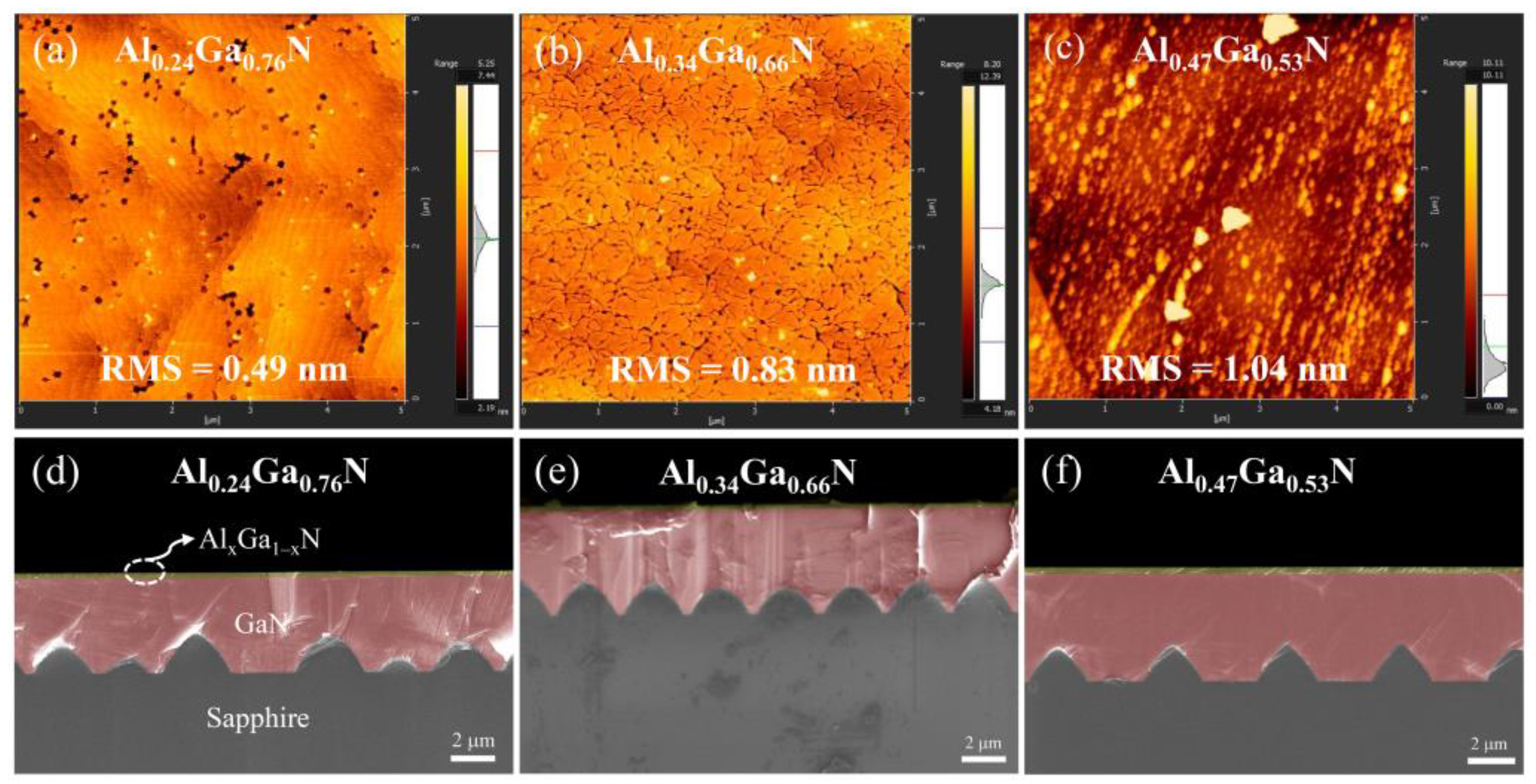


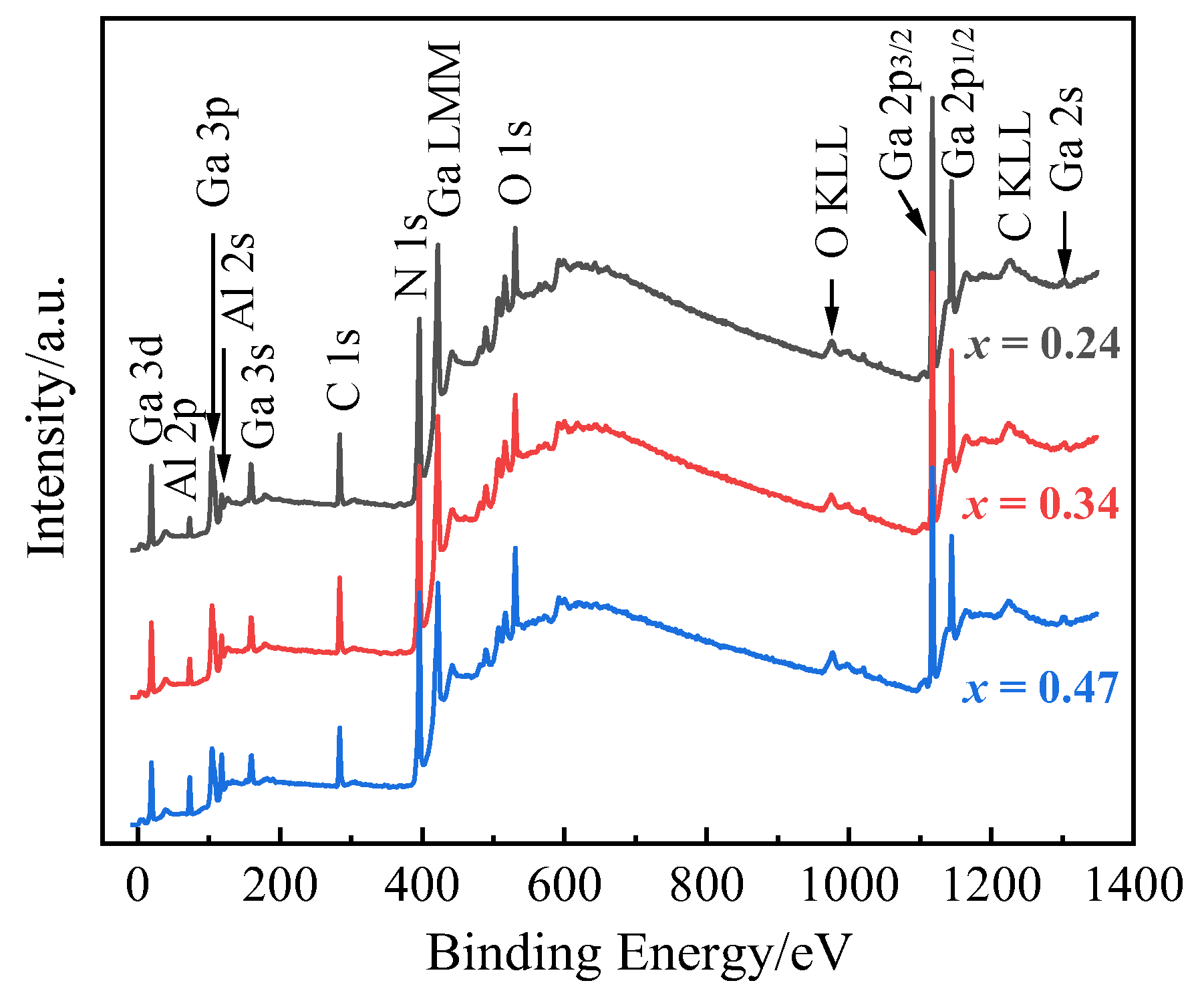
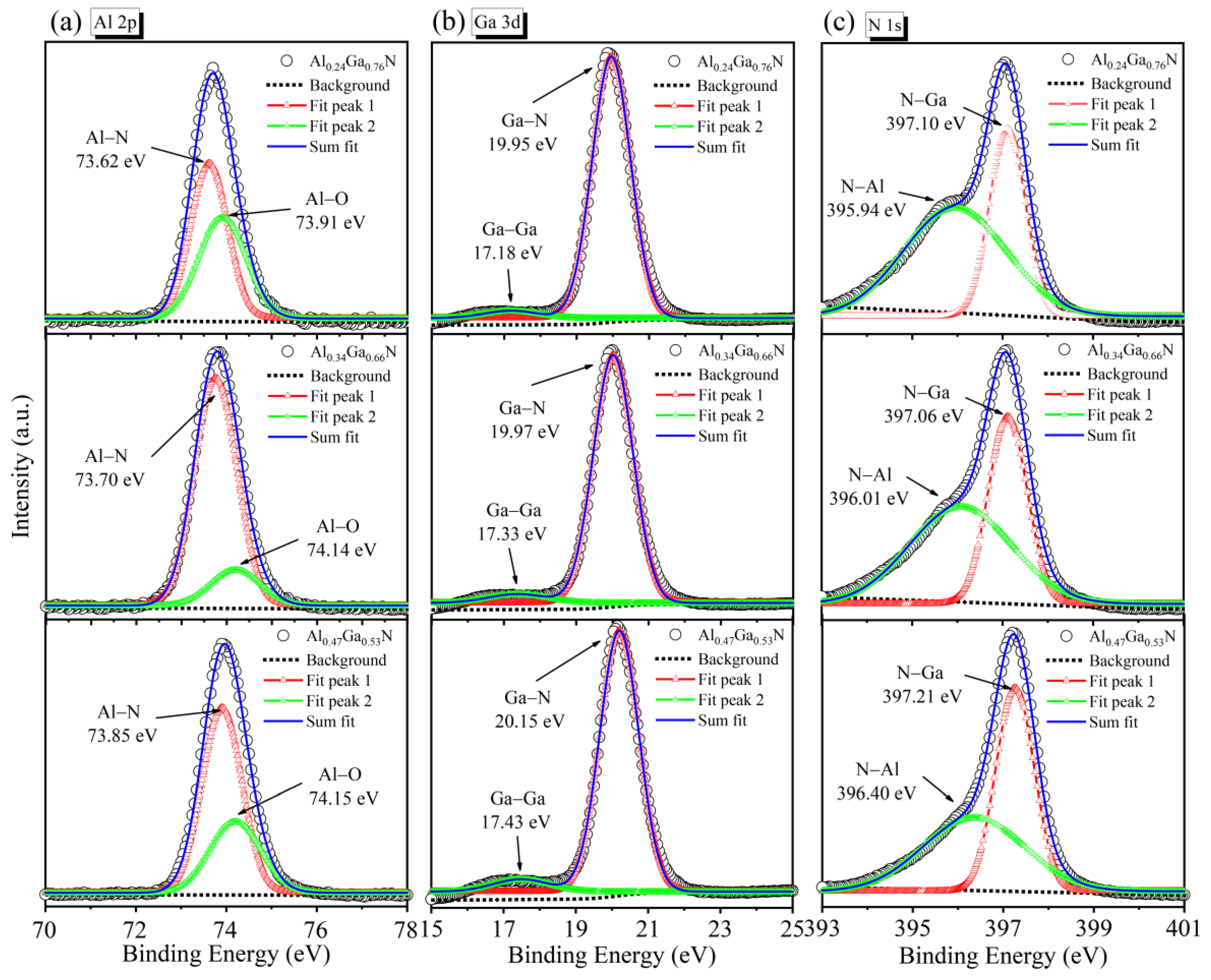

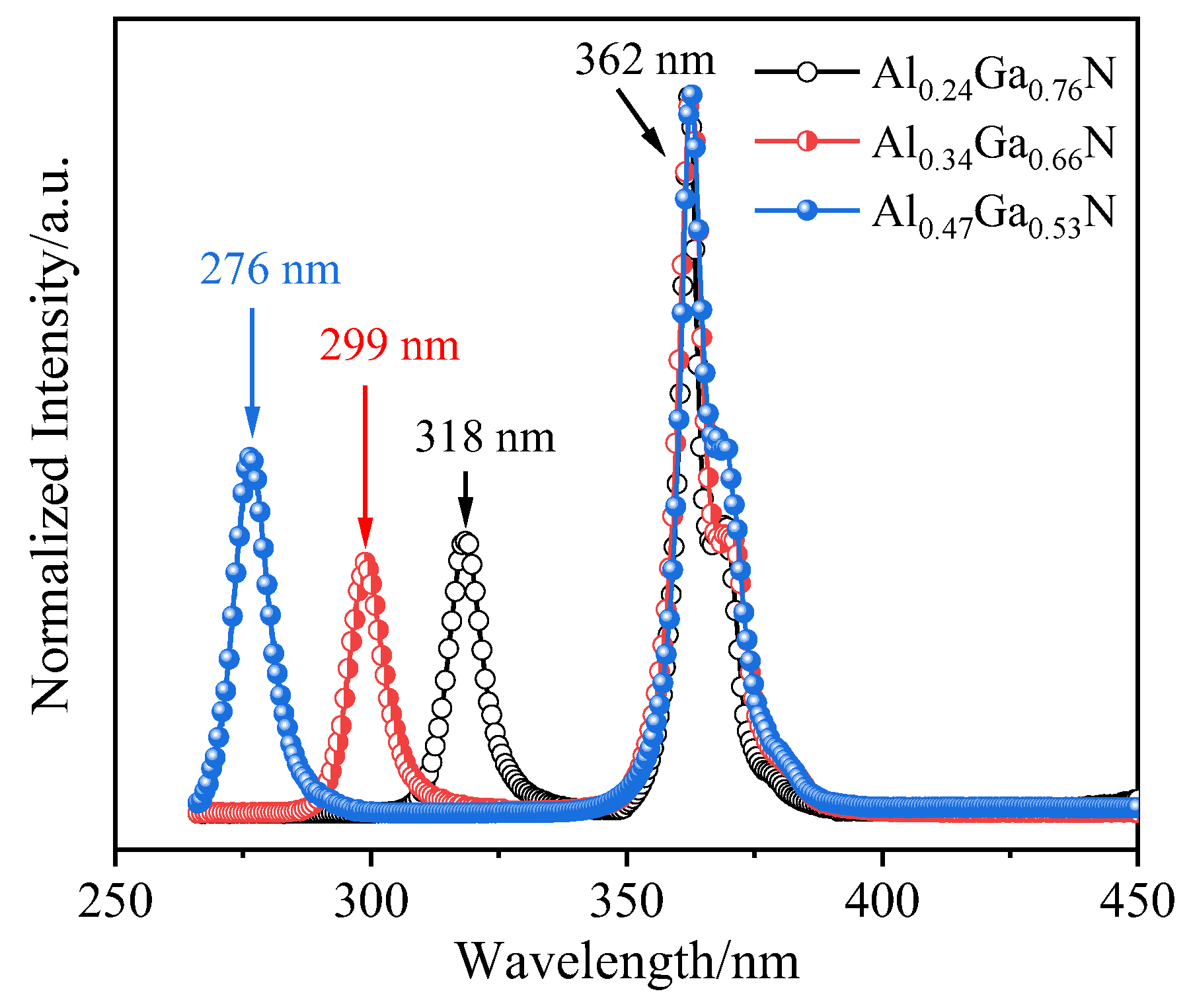
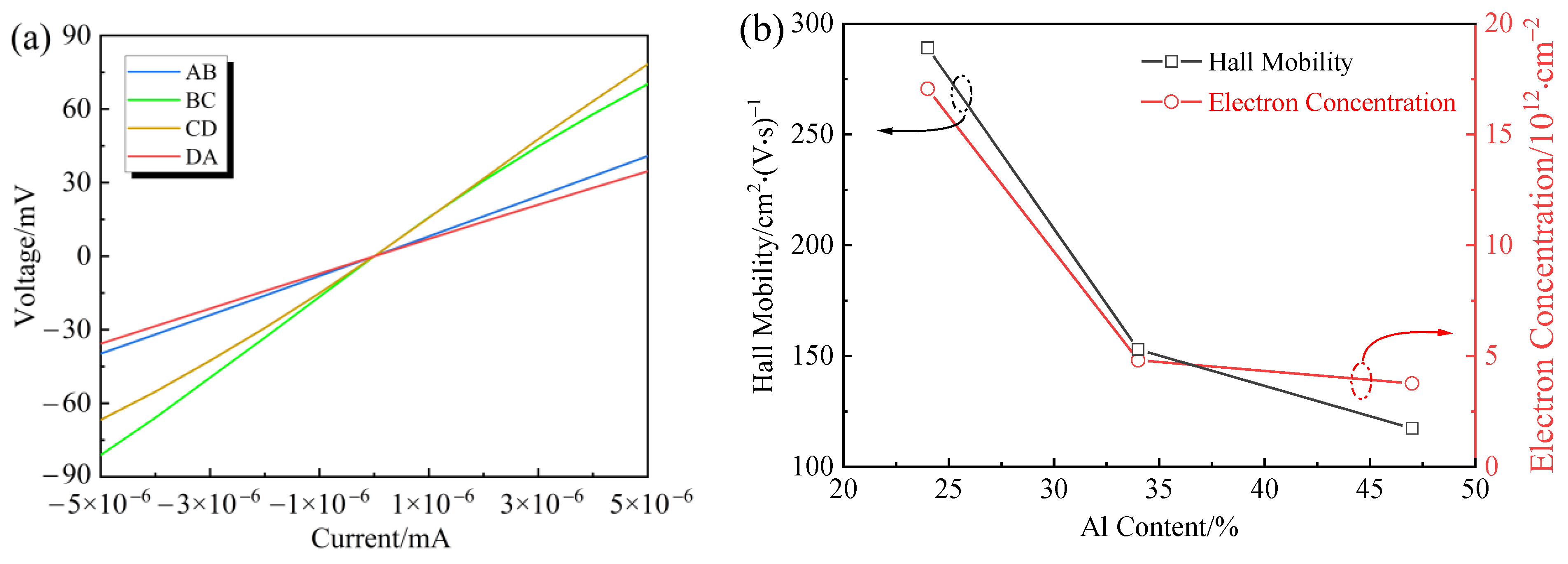
| Sample No. | Thickness (μm) | L// (μm) | βt (°) | L⊥ (μm) | Screw Dislocation Densities (108 cm−2) | Edge Dislocation Densities (109 cm−2) | Mixed Dislocation Densities (109 cm−2) | RSM (nm) | |
|---|---|---|---|---|---|---|---|---|---|
| GaN | 4.30 | 0.216 | 0.0217 | 0.135 | 0.0583 | 0.96 | 0.32 | 0.42 | 0.50 |
| Al0.24Ga0.76N | 0.20 | 0.145 | 0.0485 | 0.163 | 0.0957 | 1.31 | 0.88 | 1.01 | 0.49 |
| Al0.34Ga0.66N | 0.22 | 0.403 | 0.0575 | 0.204 | 0.1046 | 1.83 | 1.53 | 1.71 | 0.83 |
| Al0.47Ga0.53N | 0.26 | 0.664 | 0.0768 | 0.251 | 0.1228 | 2.40 | 2.85 | 3.09 | 1.04 |
| Type of Substrate | Al Content | Screw Dislocation Density (cm−2) | Edge Dislocation Density (cm−2) | Root Mean Square (nm) | PL Peaks (eV) | In-Plane Strain εxx | Sheet Carrier Density (cm−2) | Mobility (cm2/V·s) | Ref. |
|---|---|---|---|---|---|---|---|---|---|
| FSS | 11% | 5.87 × 107 | 5.89 × 108 | 0.26 | 3.66 | – | – | – | [8] |
| FSS | 14% | 1.9 × 108 | 2.5 × 109 | 0.34 | 3.68 | 0.000 | – | – | [24] |
| 26% | 2.5 × 108 | 1.0 × 109 | 0.36 | 3.93 | −8.37 × 10−4 | – | – | ||
| 45% | 5.2 × 108 | 6.2 × 109 | 0.81 | 4.43 | −1.53 × 10−2 | – | – | ||
| FSS | 25% | 3.51 × 108 | 3.65 × 109 | 0.402 | – | – | 1.02 × 1013 | 1508 | [25] |
| FSS | 25% | 1.81 × 108 | 1.37 × 109 | 0.63 | – | – | 1.45 × 1013 | 1300 | [29] |
| FSS | 45% | 2.10 × 108 | 3.70 × 108 | 0.176 | – | −1.80 × 10−3 | – | – | [36] |
| FSS | 15% | 2.42 × 108 | 2.718 × 109 | 0.26 | 3.73 | – | – | – | [41] |
| 20% | 2.91 × 108 | 3.053 × 109 | 0.49 | 3.81 | – | – | – | ||
| 33% | 4.22 × 108 | 5.102 × 109 | 1.17 | 4.09 | – | – | – | ||
| 51% | 5.43 × 108 | 5.881 × 109 | 1.48 | 4.45 | – | – | – | ||
| FSS | 24% | 9.36 × 108 | – | – | – | 1.56 × 1013 | 1360 | [43] | |
| FSS | 30% | 1.35 × 108 | 6.98 × 109 | 0.845 | – | – | – | – | [44] |
| PSS | 24% | 6.81 × 108 | – | – | – | 10.90 × 1013 | 539 | [43] | |
| PSS | 24% | 1.31 × 108 | 0.88 × 109 | 0.49 | 3.90 | −3.34 × 10−4 | 1.71 × 1013 | 289.14 | This work |
| 34% | 1.83 × 108 | 1.53 × 109 | 0.83 | 4.15 | −3.46 × 10−3 | 0.48 × 1013 | 152.94 | ||
| 47% | 2.40 × 108 | 2.85 × 109 | 1.04 | 4.49 | −8.10 × 10−3 | 0.37 × 1013 | 117.34 | ||
Disclaimer/Publisher’s Note: The statements, opinions and data contained in all publications are solely those of the individual author(s) and contributor(s) and not of MDPI and/or the editor(s). MDPI and/or the editor(s) disclaim responsibility for any injury to people or property resulting from any ideas, methods, instructions or products referred to in the content. |
© 2024 by the authors. Licensee MDPI, Basel, Switzerland. This article is an open access article distributed under the terms and conditions of the Creative Commons Attribution (CC BY) license (https://creativecommons.org/licenses/by/4.0/).
Share and Cite
Wei, W.; Yang, Y.; Peng, Y.; Maraj, M.; Sun, W. Optical and Electrical Properties of AlxGa1−xN/GaN Epilayers Modulated by Aluminum Content. Molecules 2024, 29, 1152. https://doi.org/10.3390/molecules29051152
Wei W, Yang Y, Peng Y, Maraj M, Sun W. Optical and Electrical Properties of AlxGa1−xN/GaN Epilayers Modulated by Aluminum Content. Molecules. 2024; 29(5):1152. https://doi.org/10.3390/molecules29051152
Chicago/Turabian StyleWei, Wenwang, Yanlian Yang, Yi Peng, Mudassar Maraj, and Wenhong Sun. 2024. "Optical and Electrical Properties of AlxGa1−xN/GaN Epilayers Modulated by Aluminum Content" Molecules 29, no. 5: 1152. https://doi.org/10.3390/molecules29051152
APA StyleWei, W., Yang, Y., Peng, Y., Maraj, M., & Sun, W. (2024). Optical and Electrical Properties of AlxGa1−xN/GaN Epilayers Modulated by Aluminum Content. Molecules, 29(5), 1152. https://doi.org/10.3390/molecules29051152







